A funny thing happens when you’re stuck at home with too much time on your hands – you think about food.
Maybe it’s simple self-preservation, but in times of stress and uncertainty, our focus shifts to the necessities of life, and what’s in the pantry becomes a top priority. I know many people used their pandemic down time to find a virtual trainer or learn a new language, but in my house, cooking dinner, without another mad, masked dash to the supermarket, became the daily diversion.
Apparently I am not alone. Stories abound of home cooks mastering momentous meals, shepherding sourdough starters into beautiful breads, learning what it really means to cook from scratch. Thanks to extra time away from the office – out of necessity, boredom or a desperate craving for a favourite restaurant dish – many found solace behind the stove.
And that’s a great thing. I’ve always been a big fan of home cooking, both for promoting healthy eating and a healthy local food system. In a poll conducted by Angus Reid with Dalhousie University’s Agri-Food Analytics Lab, nearly half of those surveyed plan to cook more at home, even post pandemic. And more of us are shopping with food supply chains and local food sovereignty in mind.
Don’t cook? Don’t worry — resolve to start by learning how to make one thing you love to eat and go from there.
We’re seeing innovations of all kinds when it comes to buying our food. Beyond weekly supermarket stops for staples, there are new ways to access local food and drink. Chefs and consumers have stepped up their support of local farmers, butchers, bakers, wineries and brewers to help ensure they survive this uncertain time. You can now order a meal kit from your favourite restaurant to cook their famous steak dinner or perfect pasta dish at home. Farmers’ markets have moved online, and farms have added weekly veggie boxes, for pick up or delivery, to their annual CSA (Community Supported Agriculture) subscriptions. You can even buy a share in a CSF (community supported fishery) program like Skipper Otto, to get local seafood from B.C. fishermen, or have Okanagan wine and cheese delivered directly to your door. According to trend watchers, the coronavirus has given consumers time to contemplate the broader issues facing our food system and motivated many to make the kind of changes that will have positive, long-term consequences for local food producers, economies and the environment.

Back to Basics
After a period of panic buying, people have settled into simpler shopping habits. Without the ease of cherry-picking ingredients from many different markets, bakeries, delis and butchers, I’m reining in the kind of meals I make, too. But that doesn’t mean our menus are boring.
In fact, the opposite may be true. With a mantra to use what’s on hand before venturing out to shop, there’s a new creative side to my cooking. I call it “cooking backwards” or The White Box Challenge – like those competitive TV chefs, every day we open the white box (refrigerator), see what needs to be used up, and create a meal with what’s at hand.
You can use a similar technique when shopping through your own freezer or pantry. Challenge yourself to pull out three random ingredients and imagine what you can cook. Use the power of your computer and Google for inspiration, turn to a chef cooking on YouTube or just crack open some of your favourite cookbooks. Then resolve to learn to cook something you love to eat.
Of course, it’s easiest if you start with classic combinations – think tomatoes, garlic, oregano or basil for a Greek or Italian-inspired dish, or soy sauce, garlic, ginger and sesame oil for an Asian meal. Remember, many of the dishes we love – whether it’s risotto, bouillabaisse, pizza, frittata, stir-fries, curries or stew — trace their roots to peasant cuisine, and cooks around the world devising something delicious with a few humble ingredients. Most of these dishes are endlessly adaptable, too. So if you learn a few techniques and some of these “mother recipes,” you can turn almost anything into an easy and admirable meal.
Choose fruits and vegetables you can store — cabbage, bok choy, carrots, celery, peppers, turnips, broccoli, kale, potatoes, apples, citrus.
This is where a well-stocked pantry comes into play. A good selection of pasta and rice, oil and vinegars, Asian sauces and condiments, canned foods, broth, dried beans and spices, are your best defence. I couldn’t live without garlic, onions, carrots, potatoes, tomatoes, cabbage, kale, radishes and celery. Luckily, many of these vegetables are easy to obtain and have a decent storage life. Eggs, milk and cheese are other essentials.
But don’t worry if you are missing an ingredient. Substitute something similar or leave it out. This is how wonderful new dishes emerge.
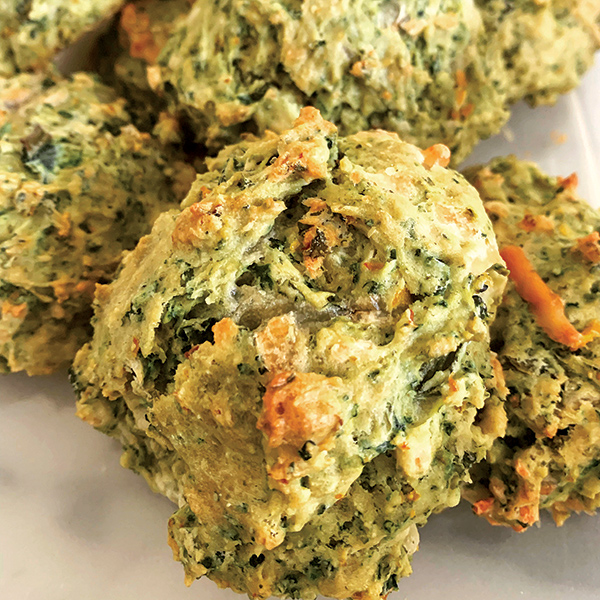
Spinach and Cheese Scones
A savoury scone is another mother recipe to use up leftovers – you can add almost any cooked vegetables, herbs and cheese to these basic buttermilk biscuits for a portable breakfast pastry. Cut smaller biscuits for savoury appetizers. If you’re using spinach or other greens, precooking is not necessary.
Ingredients
1 cup ........................................................all-purpose flour
1 cup ......................................................whole wheat flour
1 1/2 tsp. ..................................................................... salt
2 tbsp. ........................................................baking powder
1/2 cup ........... unsalted butter, chilled and cut into cubes
1 cup ......................packed spinach, chopped (or cooked
vegetables such as steamed broccoli, roasted red pepper,
caramelized onion, etc.)
1/4 cup ........................... cooked and crumbled bacon or
slivered prosciutto (optional)
1 ....................................................... green onion, minced
1 tbsp. ..............chopped fresh herbs (dill, basil, oregano)
1 cup ......shredded old cheddar (or feta, Gruyere, Gouda)
1/2 cup .......................... half-and-half cream or buttermilk
1 ..................... sprinkle of poppy seeds or sesame seeds
Method
- Preheat the oven to 350ºF.
- In a food processor, combine the flours, salt, baking powder and butter. Pulse until the mixture resembles coarse crumbs, then transfer to a bowl.
- Chop the vegetables and stir into the dry ingredients along with the green onion, herbs and cheese. Add just enough cream to make a soft dough (depends on how wet the vegetable mixture is), stirring with a fork until the mixture just comes together. Don’t work the dough too much – the less you handle it, the flakier your scones will be.
- Dump the dough out onto a floured work surface and knead gently, then pat lightly into a rectangle about 1 1/2 to 2 inches thick. Cut into 4-inch squares, then cut the squares crosswise into triangles. Alternatively, make rustic drop scones or use a round biscuit cutter. Set the scones on a baking sheet that has been lined with parchment paper. Using a pastry brush, brush the tops lightly with extra cream, and sprinkle with seeds.
- Bake in a preheated oven for 20 to 25 minutes, until golden, then transfer to a rack to cool slightly. Serve warm with butter. Makes eight large scones.
Recipe from The Waste Not, Want Not Cookbook by Cinda Chavich (Touchwood Editions).
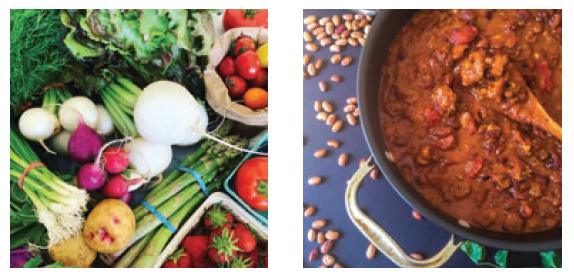
Don't Waste It
Turn shredded carrot, cucumber, daikon, turnips or roasted beets into a quick pickle with salt and vinegar, to add sharp contrast to any plate.
Nobody likes to waste food, but when you’re shopping weekly rather than daily it can be difficult to calculate your needs.
One way to make sure you don’t end up hoarding or wasting fresh food is to make a meal plan and take an inventory of what you have on hand before you shop. Clean out the fridge and get rid of any science experiments lurking in the crisper, but before you send anything to the compost bin, consider how you can save it.
Even limp herbs and greens – whether arugula, basil, spinach or chard – make a perfectly passable pesto when whirled up in the blender with a bit of garlic and olive oil. I like to mix chopped greens into hot pasta, cook them with rice, lemon and dill, or bake them into cheese scones.
Other vegetables that are getting a little soft or wrinkly are perfect candidates for roasting. Think about tossing the ripe cherry tomatoes, broccoli, cauliflower, Brussels sprouts, and beets with a little olive oil, and roasting them to bring out sweet caramelized flavours and extend their life.
Use up perishable items like lettuce, berries and green beans first, and cook anything that’s past its prime.
Turn your excess tomatoes, peppers and eggplant into a Thai curry with coconut milk, or an Italian caponata antipasto, seasoned with balsamic and pesto. Of course, overripe bananas always call for banana bread. But squidgy blueberries, strawberries or apples can simply be simmered with a little sugar for a fruity sauce to serve over pancakes or stir into plain yogurt for breakfast. And never throw out that beautiful artisan bread – even a stale loaf makes lovely crostini toasts, croutons, breadcrumbs or a tasty bread pudding.
Cutting down on waste saves you money and saves the planet, conserving resources and slowing global warming. A 2019 report published by Value Chain Management International and Second Harvest says nearly 60 per cent of food produced in Canada – amounting to 35.5 million metric tonnes – is lost and wasted annually. Nearly half of that food waste occurs in our own homes. Food waste accounts for eight per cent of the world’s greenhouse gas emissions, and if food waste were a country, it would rank just behind China and the United States in terms of its impact on climate change. It doesn’t make sense to waste food when a global crisis puts food production and supply chains in jeopardy. During world wars, food shortages led to rationing and every household took steps to ensure no food was wasted, growing victory gardens and preserving precious food by canning, smoking, freezing, and fermenting.
So with a few basic skills you can feel more confident in the kitchen and more self-sufficient. Food is comforting. And it’s empowering to know there’s a sourdough starter in the fridge and you can bake a loaf of bread when you need it!
Speedy Thai Chicken Salad
With leftover roast chicken, steamed Asian noodles and romaine lettuce, this spicy chicken salad makes
a super summer meal for dining on the deck. Substitute leftover grilled steak or rare roast beef,
thinly sliced, for an equally delicious dinner.
Ingredients
For the dressing:
1 tbsp. .............................................................minced garlic
1 tbsp. .............................................. Asian garlic chili paste
(a hot condiment called sambal oelek)
1/2 cup ............ sweet Indonesian soy sauce (ketjap manis)
6-8 tsp. .......................fresh lime juice (juice of 1 large lime)
1 tbsp. .................................................................sesame oil
For the salad:
1/2 pound ............................ thin Oriental steamed noodles
6 cups ................chopped romaine lettuce or mixed greens
1/2 cup ....................................fresh mint leaves, shredded
1/4 cup ............................................fresh cilantro, chopped
1 large ....................................carrot, peeled and shredded
1/2 ................................English cucumber, seeded and cut
into matchstick pieces
1 pound ............barbecued chicken, deboned and slivered
(or grill two boneless, skinless chicken breasts)
1/2 cup ..............................................finely diced red onion
1/2 cup ............................... dry roasted peanuts, chopped
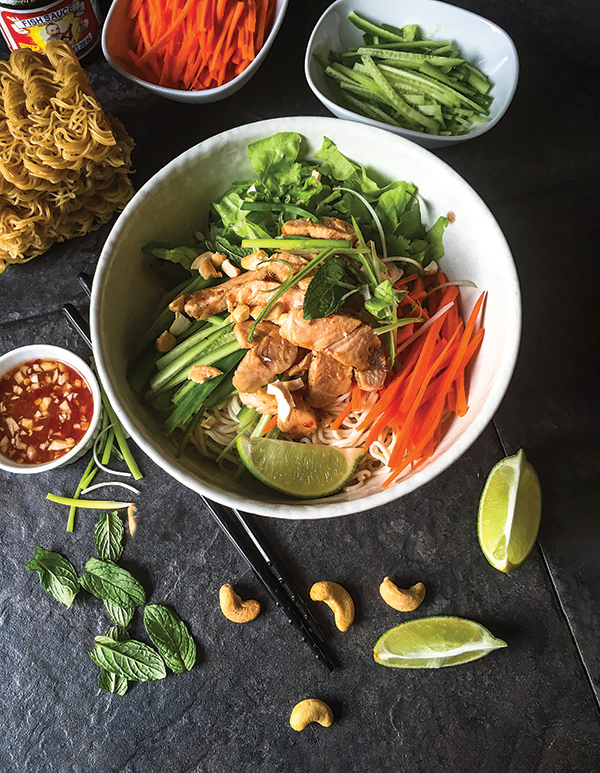
Method
- Whirl the dressing ingredients together in a food processor or blender until smooth. Dressing may be made a day in advance and refrigerated.
- Boil a very large pot of water and add the noodles. Cook them just for a couple of minutes, then drain well in a colander in the sink and rinse under cold water to chill.
- In a large salad bowl, combine the lettuce, half the mint and half the cilantro, and shredded carrot. Add just enough dressing to lightly coat the vegetables and toss well. In a separate bowl, toss the cold noodles with some of the remaining dressing (leftover dressing keeps well refrigerated for several days).
- Divide the salad mixture among four large bowls. Top each salad artfully with a pile of noodles, some cucumber, slivers of cooked chicken, the remaining mint and cilantro, and the onion. Sprinkle with chopped peanuts to garnish. Serves four.
Recipe from The Waste Not, Want Not Cookbook by Cinda Chavich (Touchwood Editions).
Cook Like a Chef
A meal plan helps but you should also be flexible. If your pantry is well stocked, it’s easier to pivot, and cook what you have on hand.
Chefs know the importance of reducing food costs and never discard good food. In the professional kitchen, leftovers land in the blue plate special or soup-of-the-day. Chefs also pre-cook or prep food in advance to make cooking meals to order fast and efficient. And that’s a great way to approach cooking at home, too.
Think about starting with a weekly feast of roast chicken or beef, grilled salmon or smoky pulled pork butt, then building new dishes around your leftover proteins. You never need to eat the same thing two days in a row, and no one will complain about eating leftovers when you turn your roast chicken leftovers into Thai Chicken Salad or chicken and avocado salsa tacos. A big pork shoulder, slow-roasted into luscious pulled pork on the barbecue (or in a low oven), makes hearty sandwiches, pineapple pork fried rice, and spicy tacos.
Or mix up a double batch of your favourite meatloaf and use half to make meatballs. You’ll have the makings of several weekday meals — meatloaf and mash, meatloaf sandwiches, spaghetti and meatballs, or meatball and new potato stew. Slice leftover grilled steak to top a salad, add to a Bahn Mi sandwich or stretch it in a big vegetable stir-fry.
Opportunity Knocks
Shop weekly and cook once, then use your leftovers and your freezer. Think about meals that reheat well – chili, stews, curries, soups, meat sauce and lasagna.
Food has always been a way to share our culture, hospitality and support, especially when times are tough. This global crisis, affecting all individuals simultaneously, is both a disaster and a gift, exposing big gaps in our food systems and opportunities for collective change in the way we eat, shop and think about feeding the world.
So how do we get through the ongoing pandemic and move forward on the food front? One delicious meal at a time!
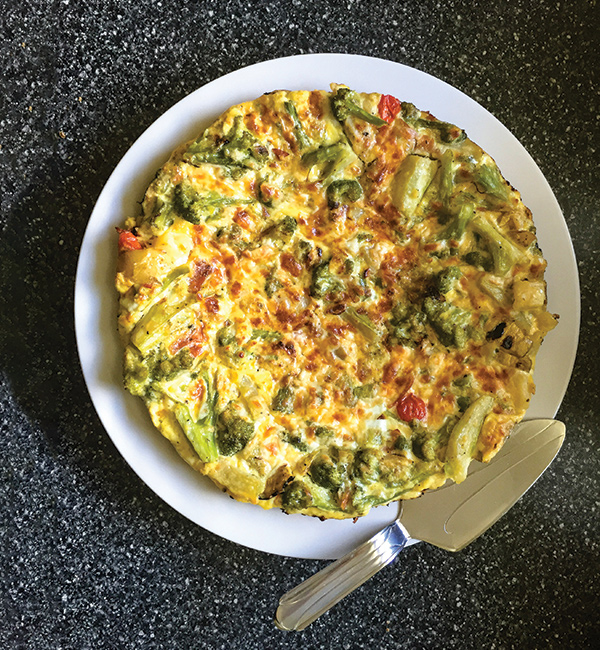
Broccoli Frittata
A frittata is another “mother” recipe that makes a simple supper, and it works well with a variety of leftover vegetables. You can even use frozen hash brown potatoes to speed up the prep.
Ingredients:
2 tbsp. ..................................................... olive oil
2 .................................... yellow-fleshed potatoes,
peeled and shredded or diced
1 ................................... medium onion, chopped
2 ...................................... cloves garlic, chopped
½ c. ........................... finely chopped red pepper
1 tbsp. ........................................... chopped basil
(or ½ tsp. Italian seasoning)
½ tsp. ............................................................ salt
½ tsp. ...................... freshly ground black pepper
6 ........................................... eggs, lightly beaten
1 c. .............................. cooked chopped broccoli
1 c. ......................................... shredded cheddar,
Gruyère, or Gouda cheese
Method:
- Preheat the broiler.
- In a large sauté pan that you can use in the oven, heat the olive oil over medium-high. Sauté the potatoes, onion, garlic, and red pepper for 5 to 10 minutes. When the potatoes begin to brown, reduce the heat to medium and stir in the basil (or Italian seasoning), salt, and pepper.
- Meanwhile, in a bowl or measuring cup, whisk the eggs until well beaten.
- When the potatoes are tender, add the chopped broccoli and stir to distribute evenly in the pan. Pour the beaten egg over top, stirring lightly and lifting the edges to allow the uncooked egg to run underneath the frittata as it begins to firm up and set. When it’s nicely browned on the bottom, and the edges are cooked (this will take about 10 minutes), sprinkle the cheese evenly over the frittata and place the pan in the oven under the broiler. Cook for about two minutes, until the cheese is melted, and the frittata is cooked through.
- Remove from the oven and set aside to cool for a minute or two before slicing into wedges to serve. Serves four.
Recipe from The Waste Not, Want Not Cookbook by Cinda Chavich (Touchwood Editions).
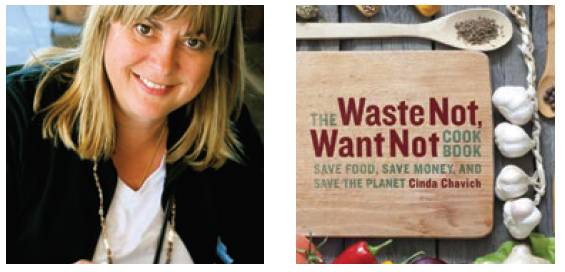
About Cinda Chavich, Food Writer
I have been a reporter and journalist for my entire adult life – thanks to a solid grounding in the craft in the journalism program at Lethbridge (then Community) College.
After studying English at university in my hometown of Regina, I ended up in southern Alberta in 1979 to immerse myself in the news business, and it’s a passion that’s never left me. As an LCC student, I edited the college newspaper, worked nights and weekends at the local daily, and graduated from the Communication Arts program at the top of my class in 1981.
My first news reporting jobs were at the Lethbridge Herald and CBC Radio, and I eventually settled into the long form world of feature writing at The Calgary Sun where, by sheer happenstance, I added the food and beverage beat to my list of lifestyle writer’s responsibilities.
Start with a weekly roast – whether beef, pork, chicken or fish – then use the leftovers in weekday sandwiches, pasta dishes, salads and stir-fries.
Eventually that led to a job as food editor and senior feature writer at the Calgary Herald, and since then my byline has appeared in many newspapers and magazines, from the Globe and Mail to Maclean’s, Canadian Living and Chatelaine. I’ve always earned my living as an editorial writer and reporter, specializing in food, beverage and travel writing, and I still approach every topic with the same curiosity and vigour as my first jobs covering crime, school boards and rural council news in Lethbridge. It’s been a job that’s taken me around the world and given me an insatiable love of research, facts and storytelling.
I also have retained my unwavering belief in the importance of independent, fact-based journalism, the basis of a democratic and just society, and something we need to support more than ever today.
As a food writer, I have long been an advocate of local and sustainable food systems, farm-to-table dining, and the producers, bakers, cooks and chefs who bring us closer to that ideal. My latest book, The Waste Not, Want Not Cookbook, looks at the global issue of food waste and how we can save food, save money, and the planet by resolving to stop wasting food at home.
Food is a basic necessity – the common language of culture and community – and the beat I continue to relish covering!



